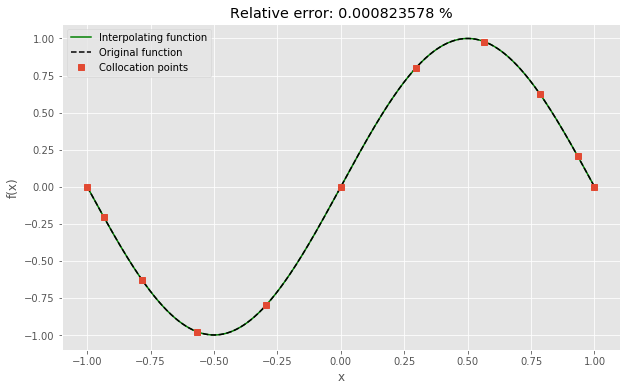Code
# Setup
%matplotlib inline
import numpy as np
import matplotlib.pyplot as plt
from gll import gll
# Prettier plots.
plt.style.use('ggplot')This notebook covers the following aspects: * Define Lagrange polynomials * Define a function to initialize and calculate Lagrange polynomial for order N * Interpolation of a function using GLL collocation points
We can approximate an arbitrary function \(f(x)\) using the interpolation with Lagrange polynomials \(l_i\) at given collacation points \(x_i\), i.e.
\[\begin{eqnarray*} f(x) = \sum f(x_i) \cdot l_i(x). \end{eqnarray*}\]
The Lagrange polynomials at \(x\) are defined as follows:
\[ \ell_i^{(N)} (x) \ := \ \prod_{k = 1, \ k \neq i}^{N+1} \frac{x - x_k}{x_i-x_k}, \qquad i = 1, 2, \dotsc , N + 1 \]
They are implemented in Python with the following code:
gll() routine to determine the collocation points for a given order \(N\) in the interval \([-1,1]\).lagrange(N,i,x,x_i) to get the \(i\)-th Lagrange polynomials of order N at the point x.# Lagrange Interpolation
# ----------------------------------------------------------------
# Initialize space in the interval [-1, 1] for plotting the original and interpolated function
nx = 1000
x = np.linspace(-1, 1, nx)
# Define an arbitrary function you want to interpolate (change it!)
f = np.sin(np.pi * x)
# Give order of Lagrange polynomial
N = 10
# Get collocation points xi from gll routine (worth having a look)
[xi, w] = gll(N)
fi = np.interp(xi, x, f)
# Initialize Lagrange polynomials on the defined grid
lp = np.zeros((N + 1, len(x)))
for i in range(0, len(x)):
for j in range(-1, N):
lp[j + 1, i] = lagrange(N, j, x[i], xi)
######################################################
# Calculate interpolating polynomials by multiplying
# Lagrange polynomials with function values at xi
s = x * 0
for j in range(0, N + 1):
s = s + lp[j, :] * fi[j]
#
######################################################
# Calculate error of original and interpolated function
error = np.sum((np.abs(f - s))) / np.sum(np.abs(f)) * 100
# -------------------
# Plot results
plt.figure(figsize=(10, 6))
plt.plot(x, s, 'k-', color='green', label='Interpolating function')
plt.plot(x, f, 'k--', label='Original function')
plt.plot(xi, fi, 's', label='Collocation points')
plt.title('Relative error: %g %%' % error)
plt.xlabel('x')
plt.ylabel('f(x)')
plt.legend(loc="upper left")
plt.show()